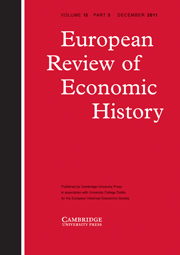Crossref Citations
This article has been cited by the following publications. This list is generated based on data provided by
Crossref.
Hale, Matthew
Raymond, Graham
and
Wright, Catherine
2010.
List of publications on the economic and social history of Great Britain and Ireland published in 2009.
The Economic History Review,
Vol. 63,
Issue. 4,
p.
1129.
Bogart, Dan
and
Richardson, Gary
2010.
Research in Economic History.
Vol. 27,
Issue. ,
p.
1.
Bogart, Dan
and
Richardson, Gary
2011.
Property Rights and Parliament in Industrializing Britain.
The Journal of Law and Economics,
Vol. 54,
Issue. 2,
p.
241.
Lamoreaux, Naomi R.
2011.
The Mystery of Property Rights: A U.S. Perspective.
The Journal of Economic History,
Vol. 71,
Issue. 2,
p.
275.
FAITH, ROSAMOND
SCHOFIELD, P. R.
HEALEY, JONATHAN
MURPHY, ANNE L.
BRADLEY, KATE
TAYLOR, JAMES
and
BROWNLOW, GRAHAM
2011.
Review of periodical literature published in 2009.
The Economic History Review,
Vol. 64,
Issue. 1,
p.
256.
Hoppit, Julian
2011.
The Nation, the State, and the First Industrial Revolution.
Journal of British Studies,
Vol. 50,
Issue. 2,
p.
307.
Libecap, Gary D.
Lueck, Dean
and
O’Grady, Trevor
2011.
Large-Scale Institutional Changes: Land Demarcation in the British Empire.
The Journal of Law and Economics,
Vol. 54,
Issue. S4,
p.
S295.
Johnson, Noel D.
and
Koyama, Mark
2012.
Taxes, Lawyers, and the Decline of Witch Trials in France.
SSRN Electronic Journal,
Brooks, Leah
and
Lutz, Byron F.
2013.
From Today's City to Tomorrow's City: An Empirical Investigation of Urban Land Assembly.
SSRN Electronic Journal,
Koyama, Mark
2013.
Preindustrial Cliometrics.
Economic Affairs,
Vol. 33,
Issue. 2,
p.
268.
Kuran, Timur
and
Rubin, Jared
2014.
The Financial Power of the Powerless: Socio-Economic Status and Interest Rates Under Partial Rule of Law.
SSRN Electronic Journal,
Johnson, Noel D.
and
Koyama, Mark
2014.
Taxes, Lawyers, and the Decline of Witch Trials in France.
The Journal of Law and Economics,
Vol. 57,
Issue. 1,
p.
77.
Ogilvie, Sheilagh
and
Carus, A.W.
2014.
Vol. 2,
Issue. ,
p.
403.
COX, GARY W.
2015.
Marketing Sovereign Promises: The English Model.
The Journal of Economic History,
Vol. 75,
Issue. 1,
p.
190.
Tarko, Vlad
2015.
The challenge of empirically assessing the effects of constitutions.
Journal of Economic Methodology,
Vol. 22,
Issue. 1,
p.
46.
Brooks, Leah
and
Lutz, Byron
2016.
From Today's City to Tomorrow's City: An Empirical Investigation of Urban Land Assembly.
American Economic Journal: Economic Policy,
Vol. 8,
Issue. 3,
p.
69.
Langlois, Richard N.
2016.
The Corporation is Not a Nexus of Contracts. It's an iPhone.
SSRN Electronic Journal ,
Johnson, Noel D.
and
Koyama, Mark
2017.
States and economic growth: Capacity and constraints.
Explorations in Economic History,
Vol. 64,
Issue. ,
p.
1.
Finley, Theresa S
Franck, Raphael
and
Johnson, Noel D.
2017.
The Effects of Land Redistribution: Evidence from the French Revolution.
SSRN Electronic Journal ,
Briggs, Chris
2018.
Land and Credit.
p.
17.


